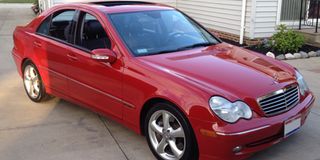The Kompressor’s stability offers safety

In simple terms, a supercharger is an air compressor, hence Mercedes-Benz’s slightly stylised Kompressor name. PHOTO/thecarexpert.co.uk
What you need to know:
The Mercedes Benz Kompressor 2003 model comes in different ranges such as the C180, C200, C230 and C240. Although, built mainly for the city centre because of its low ground clearance, motorists say it can be relied on for safety, writes Roland D. Nasasira.
Elijah Onek
After driving the Mercedes Benz Kompressor for six years, I can comfortably say it is one of the most stable cars I have ever driven.
Once, while driving from Malaba, Tororo District to Kampala, in Bugiri, a reckless motorist from the oncoming side abruptly overtook a number of trucks parked by the roadside. I had also prepared to overtake but when I flashed lights at the motorist from the oncoming side, they did not slow down. I was driving past the 120km/hour mark but had to brake and slow down to allow them overtake first. In all this, my vehicle did not skid nor lose stability.
Additionally, the Kompressor rarely experiences mechanical issues. Depending on how you drive, it is possible to spend a year without taking it to the garage. However, I always replace the suspension bushes once a year. These cost Shs350,000 for the front bushes and those at the rear last much longer. Replacement of the shocks depends on your driving habits but they also require replacement after approximately three years of rough driving. Locally, they cost approximately Shs500,000 and much less when you import from Dubai.
The Kompressor C180 uses seven litres of synthetic oil and this will cost you approximately Shs240,00 while the oil filter will cost Shs50,000 and the air cleaner Shs60,000. On average, I would spend approximately Shs400,000 on minor service. The beauty with this car is that its service runs up to 10,000km, which is almost a year. For safety, I preferred servicing it after six months.
Stewart Kalema
A Mercedes Benz Kompressor is a car that was not manufactured for hard work. The fact that it has low ground clearance, which is one of the aspects I do not like, means it dictates where and how you drive it. For instance, when I bought it, I was a resident of Buwaate in Wakiso District, but because of the rough marrum roads, I had to relocate to Kyanja, a Kampala suburb, where the roads are much better.
That aside, it is a car that will give you value for money if well maintained. If you want to drive for longer periods without servicing, a Kompressor is not the car you should go for. Every four to eight months when I visit the garage, I spend approximately Shs600,000 and this includes replacing engine oil, oil filter, air cleaner and a few other parts.
Isaac Kigozi
One of the features I like about the Kompressor is its safety elements. It has the ability to stop when you brake instantly without overturning. I was driving on the highway once and a cow suddenly crossed the road. I thought of dodging it but there was an oncoming car and the only solution was to brake instantly. It took me less than 20 seconds to stop the car from 130km/hour to zero.
Another time, I was driving at 100km/hour and I had not seen a large road hump ahead of me. I hit it and thought the car would overturn but it surprisingly remained stable and firm on the road. Besides braking efficiently, it also has seven airbags. All the doors are fitted with airbags and so is the dashboard and one at the driver’s knee area.
It is a high performance car with pocket-friendly fuel consumption. My model runs on a 2000cc engine. On a full tank, I once drove from Kampala to Busia and back to Kampala. When I checked the gauge after parking, I was left with almost half a tank.
I spend approximately Shs220,000 on fuel in a week from my home in Naalya to Kampala City Centre (a distance of about 12km) for work. Without traffic jam or when I leave home and work before the traffic jam builds up, I spend between Shs150,000 to Shs180,000 per week.




